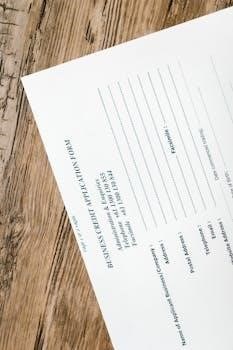Cortisol Saliva Collection Instructions⁚ A Comprehensive Guide
This guide offers comprehensive instructions for collecting saliva samples to measure cortisol levels accurately. Proper collection techniques are vital for reliable results. By following these instructions, you can ensure the integrity of your sample and contribute to accurate testing.
Salivary cortisol testing offers a non-invasive method to assess cortisol levels, a key hormone related to stress and metabolism. Unlike blood tests, saliva collection is convenient and can be done at home. Salivary cortisol reflects the unbound, active form of the hormone, providing valuable insights into adrenal function and stress response. This method is particularly useful for detecting high cortisol levels, especially when measured in a midnight saliva sample, offering a practical alternative to more invasive procedures.
Why Saliva Cortisol Testing?
Saliva cortisol testing is preferred due to its non-invasive nature and convenience. It allows for easy at-home collection, eliminating the need for blood draws. This method accurately reflects active cortisol levels, aiding in stress and adrenal function assessment.
Measurement of Active Cortisol
Salivary cortisol measurement offers a unique advantage by estimating the cortisol form most active in the body. Unlike blood tests, saliva samples primarily contain unbound cortisol, the fraction readily available to tissues. Studies show high correlations between serum and salivary cortisol levels. Salivary cortisol levels are unaffected by salivary flow rate. This makes salivary cortisol an accurate reflection of physiological stress and adrenal activity, useful for assessing various health conditions.
Convenience of Saliva Collection
Saliva collection presents a convenient alternative to blood sampling, eliminating the discomfort and invasiveness associated with venipuncture. It allows for sample collection in non-clinical settings, such as at home, increasing accessibility and reducing patient burden. Saliva collection is easily self-administered, promoting greater participation in research studies and clinical monitoring. The non-invasive nature of saliva collection makes it particularly suitable for children and individuals with anxiety related to needles, enhancing compliance and data collection.
Saliva Collection Protocol
The protocol ensures accuracy through consistent materials, standardized methods for adherence, and control of confounding agents. Following these guidelines is essential for obtaining reliable salivary cortisol measurements for research and clinical purposes.
Consistent Use of Collection Materials
To ensure accurate and reliable salivary cortisol measurements, it is essential to use collection materials consistently. This includes using the same type of collection device, such as Salivettes or SuperSAL kits, for all samples within a study or individual testing protocol. Consistent use of collection materials minimizes variability and helps maintain the integrity of the samples, leading to more accurate results. Always adhere to the manufacturer’s instructions for the specific collection device being used.
Standardized Methods for Adherence
Implementing standardized methods is crucial to promote adherence to the saliva collection protocol. Clear, concise instructions should be provided to participants, minimizing any ambiguity. These instructions should be easy to understand and follow, reducing the burden on the individual. Standardized methods also involve setting specific collection times, such as between 11⁚00 PM and midnight, and avoiding activities like eating or brushing teeth beforehand. These measures ensure consistency and improve the reliability of the cortisol measurements.
Controlling Confounding Agents
To ensure accurate salivary cortisol measurements, it is essential to control confounding agents. Steroid inhalers should be avoided for 24 hours before collection to prevent interference. If gums are bleeding, sample collection should be postponed. Rinsing the mouth with water is permissible to remove food particles, but it should be done cautiously and at least 10 minutes before collecting the sample. These precautions help minimize external factors that could affect cortisol levels and compromise test results, leading to more reliable outcomes.
Before Sample Collection
Prior to collecting your saliva sample, there are crucial steps to follow. These precautions ensure the accuracy of your cortisol test results. Adhering to these guidelines is essential for reliable data.
Avoid Steroid Inhalers
To ensure the accuracy of your saliva cortisol test, refrain from using any steroid inhalers for a minimum of 24 hours before collecting your sample. Steroid inhalers can contain substances like hydrocortisone, which may interfere with the test results and lead to inaccurate measurements of your natural cortisol levels. Disregarding this precaution can compromise the test’s validity and necessitate a repeat collection, therefore avoid steroid inhalers.
Do Not Collect if Gums are Bleeding
Avoid collecting a saliva sample if your gums are bleeding or if there’s any bleeding inside your mouth. The presence of blood in the saliva sample can significantly affect the cortisol measurements, leading to inaccurate results. Blood contamination can interfere with the laboratory analysis and compromise the integrity of the test. If you experience gum bleeding, postpone the collection until the bleeding has completely stopped to ensure an accurate cortisol assessment.
Rinsing Mouth (with Caution)
Rinsing your mouth with water before collecting a saliva sample can help remove any food particles or residue that might interfere with the test. However, caution is advised. Avoid using mouthwash or any antiseptic solutions, as these may contain substances that could affect the cortisol levels. If rinsing is necessary, use plain water and wait at least 10 minutes before collecting the saliva sample to minimize any potential interference with the results. Rinsing is not recommended for awakening samples.

Instructions for Collection
Follow these instructions precisely to ensure accurate cortisol level measurement. Consistency is key. Deviating from the protocol may compromise results. If you have any questions, consult the lab or healthcare provider.
Timing⁚ 11⁚00 PM to Midnight
Collect your saliva sample precisely between 11⁚00 PM and midnight. This timeframe is critical because cortisol levels are typically highest around midnight. Collecting outside this window will necessitate repeating the test, as it’s a time-sensitive collection. Ensure you adhere strictly to this timing for reliable and accurate cortisol measurement. This precise timing captures peak levels, aiding in accurate assessment and diagnosis, and avoiding deviations is essential.
No Brushing Teeth Before Collection
Avoid brushing your teeth before collecting your saliva sample. Brushing can introduce contaminants into the saliva, potentially affecting cortisol measurements. Residue from toothpaste or mouthwash might interfere with laboratory analysis, leading to inaccurate results. Refrain from brushing for a specified period before collection to ensure a pure saliva sample. Following this guideline helps maintain the integrity of the sample and ensures the accuracy of the cortisol level assessment in laboratory analysis, therefore increasing validity.
No Eating or Drinking 15 Minutes Prior
To ensure accurate cortisol level measurements, refrain from eating or drinking anything for at least 15 minutes before collecting your saliva sample. Food particles or liquids can contaminate the sample, potentially altering the cortisol concentration. This brief period of abstaining from consumption helps eliminate potential interference with the laboratory analysis. Maintaining this guideline will help in ensuring the validity of the sample and contributes to reliable and precise cortisol testing, giving a clear result for further healthcare decisions.
After Sample Collection
Following saliva collection, proper handling is crucial. Record the time and date immediately. Contaminated samples, visibly containing blood, should be recollected to ensure accurate cortisol level measurement for a reliable test result.
Recording Time and Date
Immediately after collecting your saliva sample, it is imperative to meticulously record the precise time and date of collection. This information is crucial for accurate interpretation of your cortisol levels. The time of collection directly correlates with expected cortisol fluctuations throughout the day. Accurate recording helps healthcare professionals assess hormonal patterns effectively. This timestamp provides context for laboratory analysis, ensuring the most relevant and reliable results for your health assessment and diagnosis.
Handling Contaminated Samples
If your saliva sample appears to be visibly contaminated with blood, it is essential to discard the sample and collect a new one. Blood contamination can significantly affect the accuracy of cortisol measurements, leading to potentially misleading results. Ensure your gums are not bleeding during the collection process. If bleeding occurs, postpone collection until it stops. Proper oral hygiene practices and gentle collection techniques can help minimize the risk of contamination. Always prioritize sample integrity for reliable cortisol testing and accurate clinical assessments.

Laboratory Analysis
Laboratory analysis involves precise saliva handling and processing. Salivary cortisol measurement utilizes validated methods. These steps ensure accurate and reliable cortisol level determination, contributing to informed clinical decisions based on test results.
Saliva Handling and Processing
After collection, saliva samples require careful handling to maintain integrity. Laboratories add a specific amount (300 µl) for liquid handling during testing. Samples visibly contaminated with blood should be recollected to avoid inaccurate results. Proper handling ensures that the saliva’s composition remains unaltered, preserving the accuracy of subsequent cortisol measurements. These procedures are critical for reliable laboratory analysis and clinical interpretation of the results.
Salivary Cortisol Measurement
Salivary cortisol measurement assesses the level of cortisol, a hormone reflecting stress response and metabolic function. The measurement estimates the form that is most active in the body. High cortisol levels are often easiest to detect in midnight saliva samples, making timing crucial. Salivary cortisol levels are relatively resistant to enzyme degradation and freeze-thaw cycles, enhancing reliability. Accurate measurement requires validated collection devices and adherence to standardized protocols for consistent results.

Collection Devices
Various devices, like Salivettes and SuperSAL kits, are used for saliva collection. These kits ensure proper sample volume and prevent contamination. Always follow the specific instructions provided with your chosen collection device for accurate cortisol measurement.
Salivette Use
To use a Salivette, remove the swab from its container, placing it in your mouth to collect saliva. Gently chew or hold the swab in your mouth for the specified time to saturate it. Replace the swab into the Salivette tube, ensuring it’s properly sealed. Send 0.5 mL saliva collected in Salivette Cortisol with blue screw cap. Follow the detailed instructions included with the Salivette kit for accurate cortisol saliva collection and analysis.
SuperSAL Universal Saliva Collection Kit
Open the SuperSAL Universal Saliva Collection Kit on a clean, dry surface. Remove the swab. Collect saliva in the provided tube(s). If needed, gently press your tongue against your teeth or suck on a button to stimulate saliva production. Do not eat, chew gum, or drink during collection. Add 300 µl to the total volume of all tests for liquid handling. Follow kit instructions for optimal cortisol saliva testing results.

Factors Affecting Saliva Cortisol Levels
Saliva cortisol levels can be influenced by several factors. These include saliva flow rate, potential enzyme degradation, and the number of freeze-thaw cycles the sample undergoes. Controlling these variables is vital for accurate results.
Salivary Flow Rate
Interestingly, salivary cortisol levels are generally considered unaffected by salivary flow rate. This is a notable advantage. It simplifies the collection process as compared to other biomarkers. However, it’s still important to ensure sufficient saliva volume is collected. This will allow for accurate testing. Factors that stimulate saliva production, such as chewing gum, should be avoided. They are not related to cortisol levels, but rather to ease of collection. Proper collection techniques should be followed.
Enzyme Degradation
Salivary cortisol demonstrates relative resistance to degradation from enzymes. This stability is beneficial for maintaining sample integrity. The enzymes present in saliva do not significantly break down cortisol. This ensures more accurate measurement. However, proper handling is crucial. Following recommended storage procedures minimizes any potential impact. Rapid processing and appropriate storage conditions should be implemented. These precautions help preserve the cortisol levels for analysis. This ensures accurate assessment of cortisol concentrations.
Freeze-Thaw Cycles
Salivary cortisol demonstrates a level of resilience to freeze-thaw cycles. However, repeated cycles can potentially impact the hormone’s integrity. While relatively robust, minimizing these cycles is recommended. Frequent freezing and thawing might cause some degradation. This could affect accurate cortisol measurement. Best practices involve aliquoting samples before freezing. This allows for single-use thawing. Proper storage protocols are essential for maintaining the hormone’s stability. This helps ensure reliable and consistent cortisol levels during analysis. Handle samples with care to avoid any degradation.
When to Consider Saliva Cortisol Testing
Saliva cortisol testing is valuable for assessing adrenal function. This non-invasive method is suitable when monitoring stress responses. It is also useful in diagnosing cortisol-related disorders, offering convenient and insightful data.
Detecting High Cortisol Levels
Saliva cortisol testing is particularly effective for detecting elevated cortisol levels, especially in midnight samples. High cortisol levels are easiest to detect in a midnight saliva sample. The protocol includes consistent use of collection materials, standardized methods to minimize subject burden, and procedures for controlling confounding factors. A saliva cortisol test measures the level of cortisol, a hormone made by the adrenal gland. Cortisol has many functions, aiding in energy metabolism and stress management.
Alternative Cortisol Tests
Besides saliva testing, alternative methods exist for measuring cortisol levels. These include midnight blood sampling, 24-hour urinary free cortisol collection, and overnight dexamethasone suppression testing. Each method offers unique advantages and disadvantages for assessing cortisol.
Midnight Blood Sampling
Midnight blood sampling involves drawing blood to measure cortisol levels at midnight, when cortisol is typically at its lowest. This method is an alternative to saliva collection but requires a visit to a healthcare facility. While invasive, blood tests can provide direct measurement of serum cortisol. However, this method may be less convenient than saliva collection due to the need for a professional blood draw and potential disruption of sleep patterns.
24-Hour Urinary Free Cortisol Collection
24-hour urinary free cortisol collection measures the total amount of unbound cortisol excreted in urine over a 24-hour period. This test provides an assessment of overall cortisol production but requires careful collection of all urine samples within the specified timeframe. It is used as an alternative to saliva cortisol testing. The collection is useful for evaluating Cushing’s syndrome but it is cumbersome for patients;
Overnight Dexamethasone Suppression Testing
Overnight dexamethasone suppression testing assesses the body’s response to dexamethasone, a synthetic steroid. Dexamethasone should suppress cortisol production in healthy individuals. This test helps diagnose Cushing’s syndrome by evaluating whether cortisol levels are appropriately suppressed. Blood samples are collected in the morning to measure cortisol levels after dexamethasone administration the night before. This alternative test is conducted when the cause of cortisol irregularities is needed.
